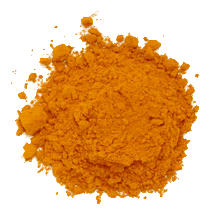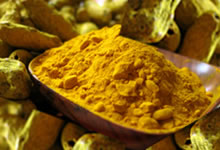Turmeric Powder : | Turmeric powder | Use of Turmeric powder | Processing Care |
| Buying and using Turmeric Powder | How to handle Turmeric Powder |
Turmeric Powder
Turmeric powder, a bright yellow spice from the rhizome of the Curcuma 
longa plant, has a long history of traditional Ayurvedic usage. Turmeric powder is made from dry Turmeric Rhizomes.
Turmeric's main ingredient is 'curcumin' which exhibit a wide range of medicinal activities. Turmeric is useful for its colour,
flavor, cosmetic and medicinal properties. The yellow color of Turmeric is due to Curcumin and related compounds, Curcuminoids present in rhizomes of turmeric in the range of 3 to 6%. The quantification of Curcuminoids in turmeric and its products is normally based on spectrophotometric measurement.
Turmeric promotes the flow of bile from the liver. Bile is one vehicle of the body, uses to excrete fat-soluble toxins. Curcumin, a potent antioxidant, is believed to be the most bioactive and soothing portion of the herb turmeric.
Use of Turmeric powder
The use of turmeric dates back nearly 3000 years to the ancient Vedic culture of India. Since then, it has been used as important spice, beauty products and in spiritual ceremonies. There are various benefits and uses of Turmeric Powder from food to medicines. There are hardly few recipes in which Turmeric Powder is not used in Indian Dishes. Almost all Indian vegetable and meat dishes use turmeric either as separate spice or in the spice mixture. A small pinch of turmeric powder would add an orange-yellow hue to salad dressings. It is also a great spice to complement recipes that use rice, lentils and dry beans. Turmeric powder is one of the most significant colouring material of India. Turmeric colour also serves as a chemical indicator since it changes its colour on adding acids or alkalis. Turmeric powder can be used for encapsulation and preparing highly beneficial Turmeric health tablets. It is an essential ingredient in various Indian food preparations for taste and colouring and in various herbal preparations. Turmeric powder, extracts and curcumin also exhibit antioxidant property. Turmeric powder's flavor could also be described as peppery, or even warm in the mouth.
Processing Care
It is necessary to care raw turmeric rhizomes freshly unearth 
for its attractive yellow colour and the characterized aroma. Without proper care turmeric lacks both.
The fingers and rhizomes of turmeric are boiled separately for 30-40 minutes until bubbles and white fumes come out, then drained and dried in the sun for 10 to 15 days, until they become dry and hard.
The dry turmeric then cleaned and polished mechanically in a drum rotated by hand or by power to make powder.
Buying and using Turmeric Powder
The flavor and aroma of turmeric is more if volatile-oil content is more. Its coloring powder is more with higher curcumin content. Turmeric most often is used in prepared mustard — where color, flavor and aroma are important, though their relative importance differs with the mustard type.
Turmeric is mixed with other coloring ingredients to attain various shades of yellows and reds. Natural colorants, such as turmeric, are becoming increasingly important to industrial users as safety issues arise for artificial coloring materials. Many food manufacturers simply prefer to keep all their ingredients natural or resulting from natural sources in response to consumer demand.
How to handle Turmeric Powder
- Turmeric Powder should be stored in a cool, dry place protected from light.
- Too much heat will volatilize and dissipate its aromatic essential oil
- High humidity will cause it to cake.
- Sunlight will cause it to fade.
- Older stock is used first.
- Tightly close containers after each use.
- Open to air for long time will cause flavor and aroma loss.